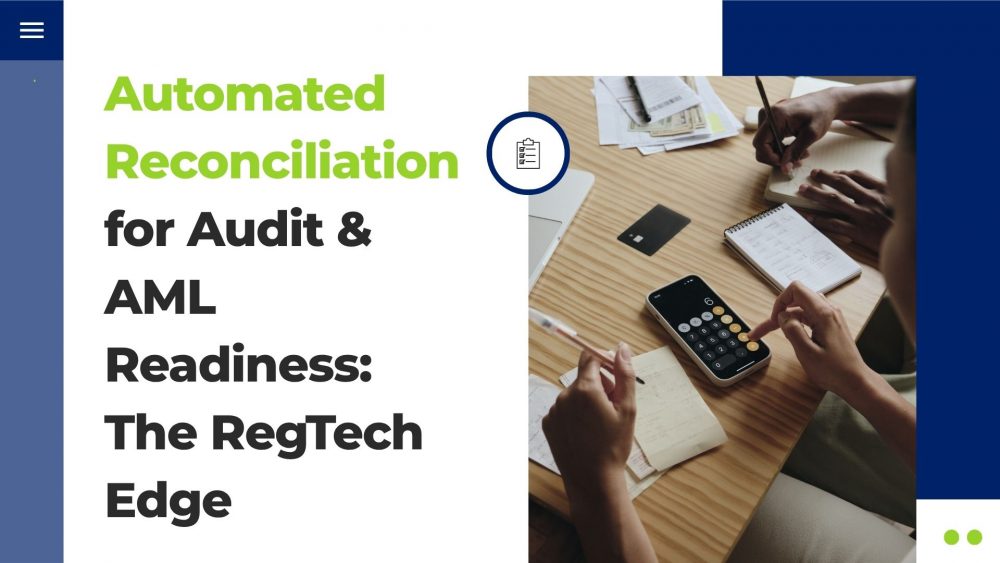Let’s be honest: financial reconciliation has never been easy, especially if you do it manually. To make matters worse, you’ve got constantly changing anti-money laundering rules, Know Your Customer requirements, and audit standards.
So, the question is: How do you stay audit-and AML-ready amidst this ever-changing regulatory landscape?
The answer is simple: automated reconciliation through AI-powered account reconciliation solutions that can help you achieve this.
This article explains how AI-enabled reconciliation can help you keep your financial records audit-ready and AML-compliant.
So, let’s start.
Five Ways Automated Reconciliation Can Help Ensure Regulatory Compliance and Audit-Readiness
Reconciling financial records has been around for centuries. What changed was the way people do it.
From clay tablets with records of debts and inventories of livestock and crops in 5000 BC, to pen-and-paper, to Excel spreadsheets in the late 2000s, and finally to automation-driven reconciliation, the reconciliation methodology has evolved significantly.
Modern AI-driven automated reconciliation systems are an indispensable part of today’s financial operations, automating multiple aspects, including data validation, anomaly detection, and reporting. Furthermore, they eliminate human error, strengthening your organisation’s ability to easily meet AML and audit regulations.
Here’s how automation bridges compliance gaps and safeguards against potential fraud risks.
1. Helps ensure data accuracy
Without accurate data, you can’t expect the effective compliance you need for every AML check, audit report, or risk assessment.
Automated reconciliation solutions integrate with ERP systems, bank feeds, and payment gateways to fetch real-time data and consolidate it. Plus, they automatically capture transactions, utilize AI to categorize them, and match records across systems to flag discrepancies instantly.
Thus, you get a unified source of truth that helps expedite quick closure and maintain consistency in the data that regulators look for.
2. Facilitates money-laundering and fraud detection
Manual reconciliation leaves your financial records exposed to human errors, like duplicate entries or omissions.
Automated reconciliation helps monitor financial flows and highlight anomalies in real time. You can consider it an early warning that prevents you from potential money-laundering risks.
For instance, if reconciliation software detects numerous round-trip transactions, it may notify you so you can investigate them further. By tracing every pound through the system, it helps identify irregularities that manual reconciliation may have missed, preventing money laundering.
3. Ensures audit-ready financial records
What matters most for auditors? Transparency, consistency, and evidence of control. Automated reconciliation software provides end-to-end traceability across all your financial data to ensure auditors get it all.
It logs every single match, exception, and resolution that occurs to create a verifiable trail that auditors can review with confidence. The result? You receive well-structured records that are updated and reconciled in real time, reducing audit time and demonstrating a mature and proactive approach to compliance.
If you run a business across multiple entities, currencies, and jurisdictions, AI-powered reconciliation solutions are even more valuable. The reason? It’s simply because you can handle complex intercompany transactions to ensure global audit readiness without requiring manual consolidation.
4. Empowers finance and accounting teams
Compliance is undoubtedly a regulatory necessity, but the benefits of AI-powered reconciliation extend beyond it to provide strategic opportunities.
First, automated reconciliation frees your finance teams from the manual reconciliation tasks. It leaves them with more time to focus on high-priority tasks related to analysis, forecasting, and strategic decision-making.
Second, AI reconciliation tools don’t simply look for data and flag issues in real time. They document everything they do, from detecting different types of errors or discrepancies to understanding why they occurred, and how they addressed them.
This extensive documentation serves as a knowledge base that enables AI tools to learn from and predict the areas where errors are likely to occur based on historical patterns. Teams can act pre-emptively to avoid major issues, rather than adopting a reactive approach to address them.
Third, automated reconciliation tools help fetch and consolidate datasets and information from multiple departments. It provides a unified, holistic overview of your company’s financial health and compliance posture, which are pivotal to informed regulatory governance.
5. Helps navigate regulatory changes and streamline alert triage
Adapting to evolving AML regulations when managing accounting or reconciliation manually can be a real challenge. This is where implementing automation tools using industry experts’ help come to your rescue. They let you update workflows and procedures based on the latest rules and regulations.
Moreover, regular transaction monitoring systems can sometimes generate false positives that overwhelm compliance teams. Combining AI-enabled intelligence and automation with transaction tracking software can help triage and prioritize alerts. It gives your analyst team to focus on high-risk cases that need human judgement.
Future Outlook: Compliance without Complexity
With regulatory expectations continuously evolving across the globe, the demand for automation in regulatory technology to ensure compliance is here to stay.
Therefore, combining AI, analytics, and automation to streamline reconciliation is no longer optional. It’s instead a necessity to stay audit-ready, maintain financial integrity, and step into the future of compliance processes with confidence.
So, it’s high time you implemented the future of AML and audit compliance – autonomous, intelligent compliance ecosystems.
AI-enabled automated accounting solutions streamline everything you need for adherence to AML and audit regulations, from reconciliation to monitoring to reporting. So, investing in these solutions is key to future-proofing your compliance frameworks and maximizing the efficiency of your entire finance team.
